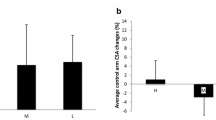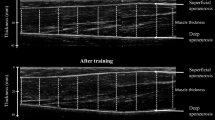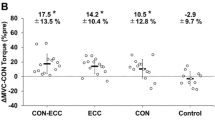Abstract
The aim of the study was to investigate how the relationship between resistance training-induced hypertrophy, strength, and passive contractile adaptations is affected by contraction duration. Twenty university students (11 males) were randomly assigned to either the fast eccentric/fast concentric phase group (F/F; 1 s both phases) or the slow eccentric/fast concentric phase group (S/F; 4 s and 1 s, respectively). Both experimental groups completed a 7-week biceps curl training programme with a total of 14 sessions (2 days/week). Elbow flexor muscle thickness (MT), one-repetition maximum (1RM), and tensiomyographic (TMG) parameters (radial displacement—Dm and contraction time—Tc) were assessed. The percentage change (∆) in MT correlated significantly with the ∆1RM only in the S/F group (r = 0.712, p < 0.05). Both groups demonstrated significant negative associations between ∆MT and ∆Dm (r = 0.717–0.760, p < 0.01). Conversely, no significance was found between ∆MT and ∆Tc (F/F: r = -0.398, p = 0.255; S/F: r = 0.410, p = 0.239), ∆1RM and ∆Tc (F/F: r = -0.278, p = 0.436; S/F: r = 0.223, p = 0.536), nor ∆1RM and ∆Dm (F/F: r = − 0.131, p = 0.719; S/F: r = − 0.351, p = 0.320). The main findings indicate that the relationship between hypertrophy and strength gains is significantly stronger when resistance training was paced with slower eccentric contractions comparing to fast ones. On the other hand, reduced Dm values indicate increase in MT regardless of contraction duration, while strength gains are not correlated with corresponding TMG changes.




Similar content being viewed by others
References
Ahtiainen JP, Walker S, Peltonen H, Holviala J, Sillanpää E, Karavirta L, Sallinen J, Mikkola J, Valkeinen H, Mero A (2016) Heterogeneity in resistance training-induced muscle strength and mass responses in men and women of different ages. Age 38(1):10. https://doi.org/10.1007/s11357-015-9870-1
Akagi R, Sato S, Hirata N, Imaizumi N, Tanimoto H, Ando R, Ema R, Hirata K (2020) Eight-week low-intensity squat training at slow speed simultaneously improves knee and hip flexion and extension strength. Front Physiol. https://doi.org/10.3389/fphys.2020.00893
Baechle TR, Earle RW (2008) Essentials of strength training and conditioning. Human kinetics
Balshaw TG, Massey GJ, Maden-Wilkinson TM, Morales-Artacho AJ, McKeown A, Appleby CL, Folland JP (2017) Changes in agonist neural drive, hypertrophy and pre-training strength all contribute to the individual strength gains after resistance training. Eur J Appl Physiol 117(4):631–640. https://doi.org/10.1007/s00421-017-3560-x
Boulard C, Gross R, Gautheron V, Lapole T (2019) What causes increased passive stiffness of plantarflexor muscle–tendon unit in children with spastic cerebral palsy? Eur J Appl Physiol 119(10):2151–2165. https://doi.org/10.1007/s00421-019-04208-4
Buckner SL, Dankel SJ, Mattocks KT, Jessee MB, Mouser JG, Counts BR, Loenneke JP (2016) The problem of muscle hypertrophy: revisited. Muscle Nerve 54(6):1012–1014. https://doi.org/10.1002/mus.25420
Burd NA, Andrews RJ, West DW, Little JP, Cochran AJ, Hector AJ, Cashaback JG, Gibala MJ, Potvin JR, Baker SK (2012) Muscle time under tension during resistance exercise stimulates differential muscle protein sub-fractional synthetic responses in men. J Physiol 590(2):351–362. https://doi.org/10.1113/jphysiol.2011.221200
Cohen J (1988) Statistical power analysis for the behavioral sciences–second edition. Lawrence Erlbaum Associates Inc., Hillsdale
Cormie P, McGuigan MR, Newton RU (2011) Developing maximal neuromuscular power. Sport Med 41(1):17–38. https://doi.org/10.2165/11537690-000000000-00000
Dahmane R, Djordjevič S, Šimunič B, Valenčič V (2005) Spatial fiber type distribution in normal human muscle: histochemical and tensiomyographical evaluation. J Biomech 38(12):2451–2459. https://doi.org/10.1016/j.jbiomech.2004.10.020
Davies TB, Kuang K, Orr R, Halaki M, Hackett D (2017) Effect of movement velocity during resistance training on dynamic muscular strength: a systematic review and meta-analysis. Sport Med 47(8):1603–1617. https://doi.org/10.1007/s40279-017-0676-4
de Paula Simola RÁ, Harms N, Raeder C, Kellmann M, Meyer T, Pfeiffer M, Ferrauti A (2015) Assessment of neuromuscular function after different strength training protocols using tensiomyography. J Strength Cond Res 29(5):1339–1348
Diniz RC, Tourino FD, Lacerda LT, Martins-Costa HC, Lanza MB, Lima FV, Chagas MH (2020) Does the muscle action duration induce different regional muscle hypertrophy in matched resistance training protocols? J Strength Cond Res. https://doi.org/10.1519/jsc.0000000000003883
Erskine RM, Fletcher G, Folland JP (2014) The contribution of muscle hypertrophy to strength changes following resistance training. Eur J Appl Physiol 114(6):1239–1249. https://doi.org/10.1007/s00421-014-2855-4
Fenwick AJ, Wood AM, Tanner BC (2017) Effects of cross-bridge compliance on the force-velocity relationship and muscle power output. PLoS ONE. https://doi.org/10.1371/journal.pone.0190335
García-Manso JM, Rodríguez-Matoso D, Sarmiento S, de Saa Y, Vaamonde D, Rodríguez-Ruiz D, Da Silva-Grigoletto ME (2012) Effect of high-load and high-volume resistance exercise on the tensiomyographic twitch response of biceps brachii. J Electromyogr Kinesiol 22(4):612–619
Gillies EM, Putman CT, Bell GJ (2006) The effect of varying the time of concentric and eccentric muscle actions during resistance training on skeletal muscle adaptations in women. Eur J Appl Physiol 97(4):443–453. https://doi.org/10.1007/s00421-006-0192-y
Haun CT, Vann CG, Osburn SC, Mumford PW, Roberson PA, Romero MA, Fox CD, Johnson CA, Parry HA, Kavazis AN (2019) Muscle fiber hypertrophy in response to 6 weeks of high-volume resistance training in trained young men is largely attributed to sarcoplasmic hypertrophy. PLoS ONE. https://doi.org/10.1371/journal.pone.0215267
Hopkins W, Marshall S, Batterham A, Hanin J (2009) Progressive statistics for studies in sports medicine and exercise science. Med Sci Sports Exerc 41(1):3
Kojić F, Ranisavljev I, Ćosić D, Popović D, Stojiljković S, Ilić V (2021) Effects of resistance training on hypertrophy, strength and tensiomyography parameters of elbow flexors: role of eccentric phase duration. Biol Sport 38(3):587–594. https://doi.org/10.5114/biolsport.2021.99323
Loenneke JP, Rossow LM, Fahs CA, Thiebaud RS, Grant Mouser J, Bemben MG (2017) Time-course of muscle growth, and its relationship with muscle strength in both young and older women. Geriatr Gerontol Int 17(11):2000–2007. https://doi.org/10.1111/ggi.13010
Loenneke JP, Buckner SL, Dankel SJ, Abe T (2019) Exercise-induced changes in muscle size do not contribute to exercise-induced changes in muscle strength. Sport Med 49(7):987–991. https://doi.org/10.1007/s40279-019-01106-9
Loturco I, Pereira LA, Kobal R, Abad CCC, Komatsu W, Cunha R, Arliani G, Ejnisman B, de Castro PA, Nakamura FY (2018) Functional screening tests: interrelationships and ability to predict vertical jump performance. Int J Sport Med 39(03):189–197. https://doi.org/10.1055/s-0043-122738
Macgregor LJ, Hunter AM, Orizio C, Fairweather MM, Ditroilo M (2018) Assessment of skeletal muscle contractile properties by radial displacement: the case for tensiomyography. Sport Med 48(7):1607–1620. https://doi.org/10.1007/s40279-018-0912-6
Meijer J, Jaspers R, Rittweger J, Seynnes OR, Kamandulis S, Brazaitis M, Skurvydas A, Pišot R, Šimunič B, Narici MV (2015) Single muscle fibre contractile properties differ between body-builders, power athletes and control subjects. Exp Physiol 100(11):1331–1341. https://doi.org/10.1113/EP085267
Moreno-Villanueva A, Pino-Ortega J, Rico-González M (2021) Effect of repetition duration—total and in different muscle actions—on the development of strength, power, and muscle hypertrophy: a systematic review. Strength Cond J. https://doi.org/10.1519/SSC.0000000000000695
Pareja-Blanco F, Rodríguez-Rosell D, Sánchez-Medina L, Gorostiaga E, González-Badillo J (2014) Effect of movement velocity during resistance training on neuromuscular performance. Int J Sport Med 35(11):916–924. https://doi.org/10.1055/s-0033-1363985
Roberts MD, Haun CT, Vann CG, Osburn SC, Young KC (2020) Sarcoplasmic hypertrophy in skeletal muscle: a scientific “unicorn” or resistance training adaptation? Front Physiol. https://doi.org/10.3389/fphys.2020.00816
Šimunič B, Koren K, Rittweger J, Lazzer S, Reggiani C, Rejc E, Pišot R, Narici M, Degens H (2019) Tensiomyography detects early hallmarks of bed-rest-induced atrophy before changes in muscle architecture. J Appl Physiol 126(4):815–822. https://doi.org/10.1152/japplphysiol.00880.2018
Stragier S, Baudry S, Poortmans J, Duchateau J, Carpentier A (2015) Contribution of muscle hypertrophy to strength gain after training in elderly adults. Comp Methods Biomech Biom Engin 18(S1):2062–2063. https://doi.org/10.1080/10255842.2015.1070593
Taber CB, Vigotsky A, Nuckols G, Haun CT (2019) Exercise-induced myofibrillar hypertrophy is a contributory cause of gains in muscle strength. Sport Med 49(7):993–997. https://doi.org/10.1007/s40279-019-01107-8
Toskić L, Dopsaj M, Stanković V, Marković M (2019) Concurrent and predictive validity of isokinetic dynamometry and tensiomyography in differently trained women and men. Isokinet Exerc Sci 27(1):31–39. https://doi.org/10.3233/IES-185152
Vann CG, Osburn SC, Mumford PW, Roberson PA, Fox CD, Sexton CL, Johnson M-R, Johnson JS, Shake J, Moore JH (2020) Skeletal muscle protein composition adaptations to 10 weeks of high-load resistance training in previously-trained males. Front Physiol 11:259. https://doi.org/10.3389/fphys.2020.00259
Vigotsky AD, Schoenfeld BJ, Than C, Brown JM (2018) Methods matter: the relationship between strength and hypertrophy depends on methods of measurement and analysis. PeerJ 6:e5071. https://doi.org/10.7717/peerj.5071
Wackerhage H, Schoenfeld BJ, Hamilton DL, Lehti M, Hulmi JJ (2019) Stimuli and sensors that initiate skeletal muscle hypertrophy following resistance exercise. J Appl Physiol 126(1):30–43. https://doi.org/10.1152/japplphysiol.00685.2018
Wilk M, Zajac A, Tufano JJ (2021) The influence of movement tempo during resistance training on muscular strength and hypertrophy responses: a review. Sport Med. https://doi.org/10.1007/s40279-021-01465-2
Wilson MT, Ryan AM, Vallance SR, Dias-Dougan A, Dugdale JH, Hunter AM, Hamilton DL, Macgregor LJ (2019) Tensiomyography derived parameters reflect skeletal muscle architectural adaptations following 6-weeks of lower body resistance training. Front Physiol 10:1493. https://doi.org/10.3389/fphys.2019.01493
Zubac D, Šimunic B (2017) Skeletal muscle contraction time and tone decrease after 8 weeks of plyometric training. J Strength Cond Res 31(6):1610–1619. https://doi.org/10.1519/JSC.0000000000001626
Author information
Authors and Affiliations
Contributions
FK designed the study and wrote the initial draft of the manuscript, with input from VI and SĐ. RA performed data analysis and assisted in the preparation of the manuscript. FK and VI designed and coordinated data collection and contributed to interpretation of data. FK and SĐ critically reviewed the manuscript. All authors approved the final version of the manuscript.
Corresponding author
Ethics declarations
Conflict of interest
No conflicts of interest, financial or otherwise, are declared by the authors.
Additional information
Communicated by Philip D. Chilibeck.
Publisher's Note
Springer Nature remains neutral with regard to jurisdictional claims in published maps and institutional affiliations.
Rights and permissions
About this article
Cite this article
Kojić, F., Arsenijević, R., Ilić, V. et al. Relationship between hypertrophy, strength gains and tensiomyography adaptations: a moderator role of contraction duration. Eur J Appl Physiol 122, 2223–2231 (2022). https://doi.org/10.1007/s00421-022-04998-0
Received:
Accepted:
Published:
Issue Date:
DOI: https://doi.org/10.1007/s00421-022-04998-0




